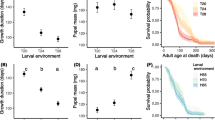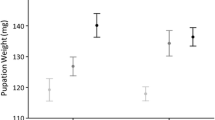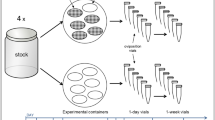Abstract
Terminal investment hypothesis is a longstanding theoretical idea that organisms should increase their reproductive effort as their prospects for survival and reproduction decline. However, numerous attempts to test the terminal investment in reproduction have yielded contradictory results. This study reports an experimental confirmation of the terminal investment hypothesis. It was predicted that immune-challenged yellow mealworm beetles (Tenebrio molitor) are more likely to follow terminal investment strategy when their food resources are limited. Our results suggest the key role of food resources while making decisions to follow a terminal investment strategy. We found that male individuals invested in their sexual attractiveness at the expense of immune response and survival when food was not available. In contrast, the beetles did not decrease their lifespan and did not invest in the attractiveness of their sex odours under conditions of food ad libitum. Our results show the importance of food availability and quality in understanding the evolution of reproductive strategies.



Similar content being viewed by others
References
Abramoff MD, Magalhaes PJ, Ram SJ (2004) Image processing with Image. J Biophot Intern 11:36–42
Bascunan-Garcia AP, Lara C, Córdoba-Aguilar A (2010) Immune investment impairs growth, female reproduction and survival in the house cricket, Acheta domesticus. J Insect Physiol 56:204–211
Bhattacharya AK, Ameel JJ, Waldbauer GP (1970) Method for sexing living pupal and adult yellow mealworms. Ann Entomol Soc Am 63:1783
Chapman RF (1998) The insects: structure and function. Cambridge University Press, Cambridge
Clutton-Brock TH (1984) Reproductive effort and terminal investment in iteroparous animals. Am Nat 123:212–229
Contreras-Garduño J, Córdoba-Aguilar A, Lanz-Mendoza H, Cordero Rivera A (2009) Territorial behaviour and immunity are mediated by juvenile hormone: the physiological basis of honest signalling? Funct Ecol 23:157–163
Contreras-Garduño J, Villanueva G, Alonso-Salgado A (2012) Phenoloxidase production: the importance of time after juvenile hormone analogues administration in Hetaerina americana (Fabricius) (Zygoptera: Calopterygidae). Odonatologica 41:1–6
Cotter SC, Ward RJS, Kilner RM (2011) Age-specific reproductive investment in female burying beetles: independent effects of state and risk of death. Funct Ecol 25:652–660
Creighton JC, Heflin ND, Belk MC (2009) Cost of reproduction, resource quality, and terminal investment in a burying beetle. Am Nat 174:673–684
Criscuolo F, Monaghan P, Nasir L, Metcalfe NB (2008) Early nutrition and phenotypic development: ‘catch-up’ growth leads to elevated metabolic rate in adulthood. Proc R Soc Lond B 275:1565–1570
Crook TC, Flatt T, Smiseth PT (2008) Hormonal modulation of larval begging and growth in the burying beetle Nicrophorus vespilloides. Anim Behav 75:71–77
Daukšte J, Kivleniece I, Krama T, Rantala MJ, Krams I (2012) Senescence in immune priming and attractiveness in a beetle. J Evol Biol 25:1298–1304
de Block M, Stoks R (2008) Short-term larval food stress and associated compensatory growth reduce adult immune function in a damselfly. Ecol Entomol 33:796–801
Dubovskiy IM, Whitten MMA, Yaroslavtseva ON, Kryukov VY, Grizanova EV, Mukherjee K, Vilcinskas A, Glupov VV, Butt TM (2013a) Can insects develop resistance to insect pathogenic fungi? PLoS ONE 8:e60248
Dubovskiy IM, Whitten MAA, Kryukov VY, Yaroslavtseva ON, Grizanova EV, Greig C, Mukherjee K, Vilcinskas A, Mitkovets PV, Glupov VV, Butt TM (2013b) More than a colour change: insect melanism, disease resistance and fecundity. Proc R Soc Lond B 280:20130584. doi:10.1098/rspb.2013.0584
Enriquez-Vara JN, Cordoba-Aguilar A, Guzman-Franco AW, Alatorre-Rosas R, Contreras-Garduno J (2012) Is survival after pathogen exposure explained by host’s immune strength? A test with two species of white grubs (Coleoptera: Scarabaeidae) exposed to fungal infection. Environ Entomol 41:959–965
Fisher DO, Blomberg SP (2011) Costs of reproduction and terminal investment by females in a semelparous marsupial. PLoS ONE 6:9
Flatt T, Tu MP, Tatar M (2005) Hormonal pleiotropy and the juvenile hormone regulation of Drosophila development and life history. BioEssays 27:999–1010
Galicia A, del Castillo RC, Contreras-Garduño J (2014) Is sexual dimorphism in the immune response of Gryllodes sigillatus related to the quality of diet? ISRN Evol Biol 329736
Gorman MJ, Schwartz AM, Paskewitz SM (1998) The role of surface characteristics in eliciting humoral encapsulation of foreign bodies in Plasmodium-refractory and -susceptible strains of Anopheles gambiae. J Insect Physiol 44:947–954
Hanssen SA (2006) Costs of an immune challenge and terminal investment in a long-lived bird. Ecology 87:2440–2446
Hoffman CL, Higham JP, Mas-Rivera A, Ayala JE, Maestripieri D (2010) Terminal investment and senescence in rhesus macaques (Macaca mulatta) on Cayo Santiago. Behav Ecol 21:972–978
Holman L (2012) Costs and constraints conspire to produce honest signalling: insights from an ant queen pheromone. Evolution 66:2094–2105
Inness CLW, Metcalfe NB (2008) The impact of dietary restriction, intermittent feeding and compensatory growth on reproductive investment and lifespan in a short-lived fish. Proc R Soc Lond B 275:1703–1708
Isaac JL, Johnson CN (2005) Terminal reproductive effort in a marsupial. Biol Lett 1:271–275
Javoiš J (2013) A two-resource model of terminal investment. Theor Biosci 132:123–132
Javoiš J, Tammaru T (2004) Reproductive decisions are sensitive to cues of life expectancy: the case of a moth. Anim Behav 68:249–255
Kivleniece I, Krams I, Daukste J, Krama T, Rantala MJ (2010) Sexual attractiveness of immune-challenged male mealworm beetles suggests terminal investment in reproduction. Anim Behav 80:1015–1021
Krams I, Daukšte J, Kivleniece I, Krama T, Rantala MJ, Ramey G, Sausa L (2011a) Female choice reveals terminal investment in male mealworm beetles, Tenebrio molitor, after a repeated activation of the immune system. J Insect Sci 11:56
Krams I, Daukšte J, Kivleniece I, Krama T, Rantala MJ (2011b) Overwinter survival depends on immune defence and body length in male Aquarius najas water striders. Entomol Exp Appl 140:45–51
Krams I, Daukste J, Kivleniece I, Brumelis G, Cibulskis R, Abolins-Abols M, Rantala MJ, Mierauskas P, Krama T (2012) Drought-induced positive feedback in xylophagous insects: easier invasion of Scots pine leading to greater investment in immunity of emerging individuals. For Ecol Manag 270:147–152
Krams I, Daukšte J, Kivleniece I, Krama T, Rantala MJ (2013a) Previous encapsulation response enhances within individual protection against fungal parasite in the mealworm beetle Tenebrio molitor. Insect Sci 20:771–777
Krams I, Daukšte J, Kivleniece I, Kaasik A, Krama T, Freeberg TM, Rantala MJ (2013b) Trade-off between cellular immunity and life span in mealworm beetles Tenebrio molitor. Curr Zool 59:340–346
Langley PA, Clutton-Brock TH (1998) Does reproductive investment change with age in tsetse flies, Glossina morsitans morsitans (Diptera: Glossinidae)? Funct Ecol 12:866–870
Marzal A, Bensch S, Reviriego M, Balbontin J, de Lope F (2008) Effects of malaria double infection in birds: one plus one is not two. J Evol Biol 21:979–987
Metcalfe NB, Monaghan P (2013) Does reproduction cause oxidative stress? An open question Trends. Ecol Evol 28:347–350
Morrow EH, Arnqvist G, Pitnick S (2003) Adaptation versus pleiotropy: why do males harm their mates? Behav Ecol 14:802–806
Nielsen ML, Holman L (2012) Terminal investment in multiple sexual signals: immune-challenged males produce more attractive pheromones. Funct Ecol 26:20–28
Paskewitz S, Riehle MA (1994) Response of Plasmodium refractory and susceptible strains of Anopheles gambiae to inoculated Sephadex beads. Dev Comp Immunol 18:369–375
Pereira R, Sivinski J, Teal PEA (2010) Influence of a juvenile hormone analog and dietary protein on male Anastrepha suspensa (Diptera: Tephritidae) sexual success. J Econ Entomol 103:40–46
Pölkki M, Kangassalo K, Krams I, Rantala MJ (2012) Inbreeding affects sexual signalling in males but not females of Tenebrio molitor. Biol Lett 8:423–425
Prokkola J, Roff D, Kärkkäinen T, Krams I, Rantala MJ (2013) Genetic and phenotypic relationships between immune defense, melanism and life-history traits at different temperatures and sexes in Tenebrio molitor. Heredity 111:89–96
Rantala MJ, Roff DA (2007) Inbreeding and extreme outbreeding cause sex differences in immune defence and life history traits in Epirrita autumnata. Heredity 98:329–336
Rantala MJ, Koskimaki J, Taskinen J, Tynkkynen K, Suhonen J (2000) Immunocompetence, developmental stability and wingspot size in the damselfly Calopteryx splendens L. Proc R Soc Lond B 267:2453–2457
Rantala MJ, Jokinen I, Kortet R, Vainikka A, Suhonen J (2002) Do pheromones reveal male immunocompetence? Proc R Soc Lond B 269:1681–1685
Reaney LT, Knell RJ (2010) Immune activation but not male quality affects female current reproductive investment in a dung beetle. Behav Ecol 21:1367–1372
Rolff J, Siva-Jothy MT (2002) Copulation corrupts immunity: a mechanism for a cost of mating in insects. Proc Natl Acad Sci USA 99:9916–9918
Sadd BM, Siva-Jothy MT (2006) Self-harm caused by an insect’s innate immunity. Proc R Soc Lond B 273:2571–2574
Sadd B, Holman H, Armitage F, Lock R, Marland R, Siva-Jothy MT (2006) Modulation of sexual signalling by immune challenged male mealworm beetles (Tenebrio molitor, L): evidence for terminal investment and dishonesty. J Evol Biol 19:321–325
Schwanz LE (2008) Chronic parasitic infection alters reproductive output in deer mice. Behav Ecol Sociobiol 62:1351–1358
Scott MP (2006) The role of juvenile hormone in competition and co-operation by burying beetles. J Insect Physiol 52:1005–1011
Sheldon BC, Verhulst S (1996) Ecological immunology: costly parasite defences and trade-offs in evolutionary ecology. Trends Ecol Evol 11:317–321
Siva-Jothy MT, Thompson JJW (2002) Short-term nutrient deprivation affects immune function. Physiol Entomol 27:206–212
Speakman JR (2008) The physiological costs of reproduction in small mammals. Philos Trans R Soc Lond B 363:375–398
Stearns SC (1992) The evolution of life histories. Oxford University Press, Oxford
Teal PEA, Gomez-Simuta Y, Proveaux AT (2000) Mating experience and juvenile hormone enhance sexual signaling and mating in male Caribbean fruit flies. Proc Natl Acad Sci USA 97:3708–3712
Trumbo ST, Robinson GE (2008) Social and nonsocial stimuli and juvenile hormone titer in a male burying beetle, Nicrophorus orbicolis. J Insect Physiol 54:630–635
Uller T, Isaksson C, Olsson M (2006) Immune challenge reduces reproductive output and growth in a lizard. Funct Ecol 20:873–879
Vainikka A, Rantala MJ, Seppala O, Suhonen J (2007) Do male mealworm beetles, Tenebrio molitor, sustain the honesty of pheromone signals under immune challenge? Acta Ethol 10:63–72
Valtonen TM, Kleino A, Rämet M, Rantala MJ (2010) Starvation reveals maintenance cost of humoral immunity. Evol Biol 37:49–57
Wilcoxen TE, Bridge ES, Boughton RK, Rensel MA, Reynolds SJ, Schoech SJ (2011) Parental, social and environmental factors associated with hatching failure in Florida scrub-jays Aphelocoma coerulescens. Ibis 153:70–77
Williams GC (1966) Natural selection, costs of reproduction, and a refinement of Lack’s principle. Am Nat 100:687–690
Worden BD, Parker PG, Pappas PW (2000) Parasites reduce attractiveness and reproductive success in male grain beetles. Anim Behav 59:543–550
Yourth CP, Forbes MR, Smith BP (2001) On understanding variation in immune expression of the damselflies Lestes spp. Can J Zool 79:815–821
Yourth CP, Forbes MR, Smith BP (2002) Immune expression in a damselfly is related to time of season, not to fluctuating asymmetry or host size. Ecol Entomol 27:123–128
Acknowledgments
The study was supported by the Academy of Finland (I.K. and M.J.R.), and by the Ministry of Education and Science of the Republic of Latvia and the Science Council of Latvia (I.K. and T.K.). We thank Inese Kivleniece for help in rearing the insects.
Author information
Authors and Affiliations
Corresponding author
Additional information
Communicated by A. Brandl.
Rights and permissions
About this article
Cite this article
Krams, I.A., Krama, T., Moore, F.R. et al. Resource availability as a proxy for terminal investment in a beetle. Oecologia 178, 339–345 (2015). https://doi.org/10.1007/s00442-014-3210-5
Received:
Accepted:
Published:
Issue Date:
DOI: https://doi.org/10.1007/s00442-014-3210-5




